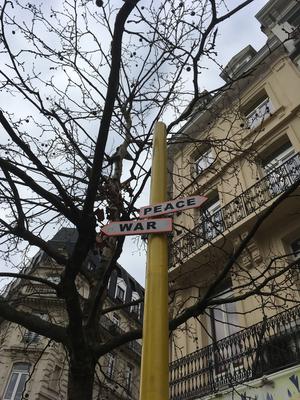War and peace
During a group observation stroll with the P-Lab team, we struck upon this sign near Bourse. It would not be entirely wrong to call it a ‘war and peace’ sign (since that is actually what it says!). The signs are – in their DIY style – quite easily identifiable as being no ‘official’ signage. Apart from the ludic and figurative message ('war & peace') that aims to spark discussion, we say quite easily because some of its design features indicate DIY-ness. Yet, some ambiguity is abound. This mainly has to do with the fact that the author(s) made use of an out-of-use bus stop pole, and they fixed the signs with clamps. This use of clamps is a sturdy way of fixing! But are these clamps that were already there, or have they been installed by the author(s) of the signs? Talking about a neat street hack!
During a group observation stroll with the P-Lab team, we struck upon this sign near to the Bourse. It would not be entirely wrong to call it a ‘war and peace’ sign (since that is actually what it says!). The signs are – in their DIY style – quite easily identifiable as being no ‘official’ signage. Apart from the ludic and figurative message ('war & peace') that aims to spark discussion, we say quite easily because some of its design features indicate DIY-ness. First of all, the signs are made of wood, and not of metal (permanent ‘official’ signs) or plastic (temporary ‘official’ signage). Also, they have not been coated to resist time and weather, nor are they reflective, nor is there a use of 'official' or 'usual' colours used to highlight, signify or make it visible in different circumstances, or convey the identity of some official city body. The scale of the signs, finally, 'does not fit' in some way (intuitively, but what way?). However some ambiguity is abound. The fact that they have been mounted on a out-of-use bus stop post, for example, can lead to some confusion. This is further reinforced by the seemginly 'right' height at which the signs are placed. High enough to be seen from some distance, and just high enough to be out of reach to be easily dismounted. But perhaps more curious, and on this we were wondering when we examined the install a bit more up close, is that the signs are fixed to the pole with clamps. This use of clamps is a sturdy way of fixing! But are these clamps that were already there, or have they been installed by the author(s) of the signs?




